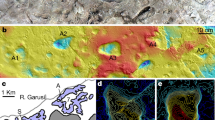These ancient tracks are the oldest known to have been made by fully bipedal humans.
Abstract
We have analysed three fossilized trackways of human footprints in a zeolite-rich pyroclastic flow dated to 385,000–325,000 years ago (kyr), discovered along the western margin of the Roccamonfina volcanic complex in southern Italy. We believe that these tracks are the oldest human footprints found so far and that they were made by hominids who had a fully bipedal, free-standing gait, using their hands only to steady themselves on the difficult descent.
Similar content being viewed by others
Main
Known locally as 'devils' trails' (and pointed out to us by Marco De Angelis and Adolfo Panarello), the three human trackways are associated with other mammalian tracks in a Middle Pleistocene pyroclastic flow known as the Brown Leucitic Tuff, from the Roccamonfina volcano in northwestern Campania, southern Italy.
The stratigraphic location and age of the trampled layer are supported by lithological comparison with the well-documented radiometric-dated series of the volcanic complex1. The development of the Roccamonfina volcano can be divided into three main phases2: the first, eruptive phase (630–385 kyr), which ended with a caldera-forming event; a second in which volcanic–tectonic events formed the Brown Leucitic Tuff (385–325 kyr) as well as later pyroclastic flow units; and a third that saw the formation of trachybasaltic lavas and ended about 50,000 years ago.
The tracks (designated here as A, B and C) occur on the surface of a single pyroclastic flow unit that probably belonged to the second phase, and they descend a steep slope that is inclined by up to 80°. The tracks have the same general direction but different stride patterns.
Trackway A is 13.40 m long and consists of 27 footprints across a difference in elevation of 4.26 m; the slope is crossed by a Z-shaped trackway that contains two sharp turns, presumably made in order to negotiate the descent more easily (Fig. 1 a–c).
a, b, Views of the western part of the site showing trail A, which descends an inclined slope (detail enlarged in b). c, d, Diagrams of trackways A and B, respectively. The trackways indicate the course taken by the trackmaker and therefore his or her direction with respect to the slope. On either side of the final two footprints in trackway B, and also about halfway along it, handprints are evident that probably result from attempts to maintain balance during the difficult descent. Scale bars, 1 m.
Trackway B is 8.60 m long and consists of 19 footprints over a difference in elevation of 2.91 m; the slope is crossed in a single straight line that curves roughly 45° to the right (Fig. 1d). The footprints are less evenly spaced after the fifth footprint, as a steeper section is negotiated, and there is evidence of slipping: an occasional handprint is seen on the slope beside the track, placed with an open palm at the side of the trunk (Fig. 1d). By contrast, trackway C (not shown) follows a straight line of 9.98 m, with 10 regular footprints over a smaller incline of 2.56 m, indicating a constant pace with no slipping.
The footprints are about 20 cm in length and 10 cm in width. Using the global average foot-length/stature ratio of 15%, the footprints indicate that the people who made them were no taller than 1.5 m. In some of the prints, the impressions made by the heel and ball of the foot are clear, and there are even small depressions that can be interpreted as toe impressions. The ball impressions have oblique principal axes that run anteromedially to what is thought to be the base of the big toe. In some cases, the central area of the footprint is raised, indicating that the foot was arched. The trackways are narrow, with an average pace of 60 cm and a stride of 120 cm. Although the footprints do not show all of the known features of contouring human bipedalism, there are enough similarities to support the idea that they are indeed human and fully bipedal3.
Although the dating of these trackways is provisional, to our knowledge they are the first human tracks discovered from the Middle Pleistocene period and are therefore the oldest to be found so far.
References
Ballini, A., Barberi, F., Laurenzi, M. A., Mezzetti, F. & Villa, I. M. Bollettino Gruppo Nazionale di Vulcanologia 5, 533–574 (1989).
De Rita, D., Giordano, G. & Milli, S. J. Volcanol. Geotherm. Res. 78, 2267–2288 (1996).
Kramer, P. A. & Eck, G. C. J. Hum. Evol. 38, 651–666 (2000).
Author information
Authors and Affiliations
Corresponding author
Ethics declarations
Competing interests
The authors declare no competing financial interests.
Rights and permissions
About this article
Cite this article
Mietto, P., Avanzini, M. & Rolandi, G. Human footprints in Pleistocene volcanic ash. Nature 422, 133 (2003). https://doi.org/10.1038/422133a
Issue Date:
DOI: https://doi.org/10.1038/422133a
This article is cited by
-
A Late Pleistocene hominin footprint site on the North African coast of Morocco
Scientific Reports (2024)
-
Evidence of the use of soft footwear in the Gravettian cave of Cussac (Dordogne, France)
Scientific Reports (2021)
-
Tracking late Pleistocene Neandertals on the Iberian coast
Scientific Reports (2021)
-
A New Pleistocene Hominin Tracksite from the Cape South Coast, South Africa
Scientific Reports (2018)
-
Walking through volcanic mud: the 2,100 year-old Acahualinca footprints (Nicaragua) II: the Acahualinca people, environmental conditions and motivation
International Journal of Earth Sciences (2010)
Comments
By submitting a comment you agree to abide by our Terms and Community Guidelines. If you find something abusive or that does not comply with our terms or guidelines please flag it as inappropriate.




